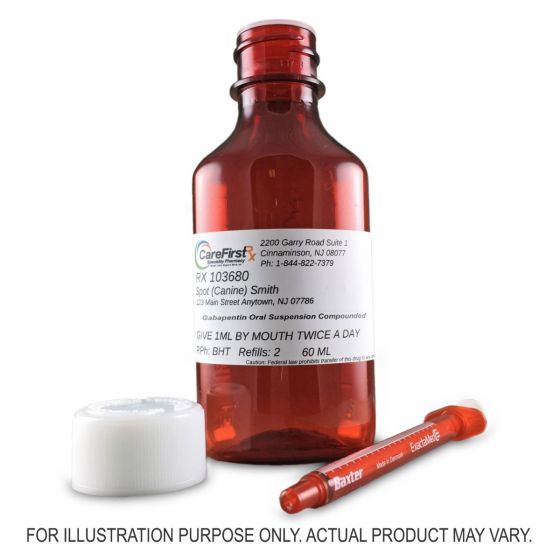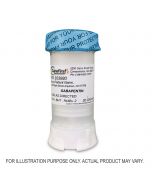Gabapentin Suspension Compounded
Gabapentin is a GABA analog used for a variety of medical conditions such as fibromyalgia, neuropathic pain, seizures, and others. It has a unique mechanism of action being that it is a GABA analog but does not affect GABA receptors. Here at CareFirst Specialty Pharmacy, we can compound gabapentin into different formulations such as capsules, oral oil suspension, creams, suppositories, and numerous other forms for use.
This medication requires a prescription.
To process your order we will require a prescription from you or your Prescriber. We will only compound and dispense upon receipt of a valid patient specific prescription. Please note that our compounds are exclusively provided for individual patient and are not for office use.
- Your prescriber can mail or fax in the prescription
- You can mail in the original prescription
- We can contact your prescriber for you
- You can transfer your prescription from another pharmacy
Are you a licensed Prescriber?
- We have convenient ways to get your prescription to us:
- Fax to (800) 786-1405 or (844) 922-7379
- Send electronically (e-prescribe) by:
- Searching for CareFirst Specialty Pharmacy in Mount Laurel, NJ 08054
- Using our NCPDP# 3151266
- Phone into (844) 822-7379
- For more information about our products and services:
- Please complete the prescriber form online
- Email us at csr@cfspharmacy.com
Looking for a Different Strength?
Contact us for a Quote.
We are a nationally accredited PCAB compounding pharmacy and a .Pharmacy verified website. A verified .Pharmacy website designation ensures our patients and prescribing partners that our website is verified and safe.
The appearance may vary from image.
Gabapentin is a GABA analog used for a variety of medical conditions such as fibromyalgia, neuropathic pain, seizures, and others. It has a unique mechanism of action being that it is a GABA analog but does not effect GABA receptors. Here at CareFirst Specialty Pharmacy we can compound gabapentin into different formulations such as capsules, oral oil suspension, creams, suppositories, and numerous other forms for use.
Pronunciation:
(GA ba pen tin)
Other Names:
Brand Names (U.S.): Gralise, Gralise Starter, Neurontin
Drug Class:
Anticonvulsant, GABA Analog
Mechanism of Action:
Gabapentin is structurally similar to GABA however it does not bind to GABA receptors and does not affect reuptake of GABA. Instead it binds to -2-δ-1 subunit of voltage-dependent Ca 2+ channels
Drug Interactions:
Do not take with the following medications: Azelastine (Nasal), Bromperidol, Orphenadrine, Oxomemazine, Paraldehyde, and Thalidomide
Consider therapy modification with the following medications: Aluminum Hydroxide, Blonanserin, Buprenorphine, Chlormethiazole, Droperidol, Flunitrazepam, Lemborexant, Magnesium Salts, Mefloquine, Methotrimeprazine, Opioid Agonists, Oxybate Salt Products, Perampanel, Suvorexant, and Zolpidem
Adverse Effects:
Common side effects you might experience: feeling dizzy, sleepy, tired or weak, diarrhea, upset stomach or throwing up, and dry mouth.
Tell your doctor if you begin to have any of these symptoms following gabapentin administration:
- Signs of an allergic reaction like a rash, hives, itching, trouble breathing, wheezing, tightness in chest and/or throat.
- Signs of liver problems like dark urine, feeling tired, not hungry, upset stomach or stomach pain, light-colored stools, throwing up, or yellow skin/eyes
- Trouble controlling body movements, twitching, change in balance, trouble swallowing or speaking.
- Memory problems or loss, change in eyesight, feeling confused or not able to focus, shakiness, or swollen glands.
Administration:
Use this drug as ordered by your prescriber.
Dosing:
Contact your healthcare provider for specific dosing instructions.
Pregnancy:
Gabapentin does cross the placenta. It is best to speak to your healthcare provider to see if benefits outweigh risks of using gabapentin while pregnant.
Breastfeeding:
Gabapentin is present in breast milk. The relative infant dose (RID) of gabapentin has been noted to be between 8.7% to 13%. RID is considered acceptable when RID is <10% and when RID is >25% breastfeeding should generally be avoided. The decision to breastfeed while taking gabapentin should consider the following: risk of infant exposure, the benefits of breastfeeding to the infant, and benefits of treatment to the mother. Based on limited information, gabapentin is considered relatively compatible with breastfeeding.
Children/Pediatrics:
For children ≥3 years of age, gabapentin is relatively safe to use; however, dosing is subject to change based on age and weight
Veterinary
Our compounding pharmacy also specializes in making gabapentin for pets. We formulate a wide variety of options for your pet, from chew treats to suspensions or even tablets making it convenient for you to decide what would be most ideal for your pet.
References:
- Gabapentin (Systemic) [Lexi-Drugs]. Lexi-Comp. Wolters Kluwer Health, Inc. http://online.lexi.com. Updated September 24 th , 2020. Accessed September 25, 2020.
- Fujii H, Goel A, Bernard N, et al. Pregnancy outcomes following gabapentin use: results of a prospective comparative cohort study. Neurology. 2013;80(17):1565-1570. doi:10.1212/WNL.0b013e31828f18c1
Gabapentin
Consult your veterinarian
This is a compounded medication specifically made for your pet based on a prescription from your licensed veterinarian. Compounded medications are not returnable.
Troches and suppositories require refrigeration (ice packs) and will incur an extra charge of $19.95 per order.










